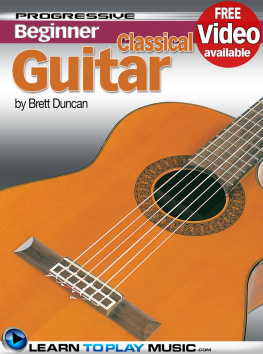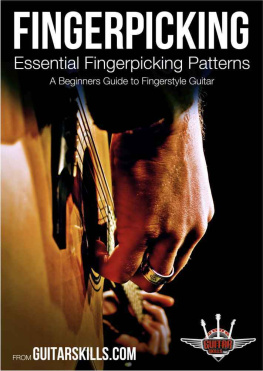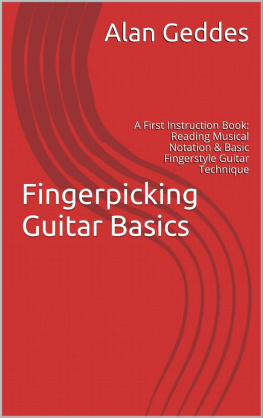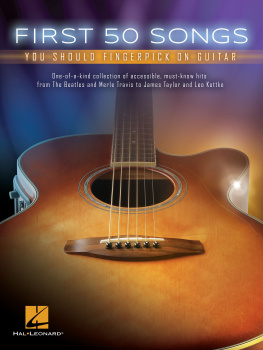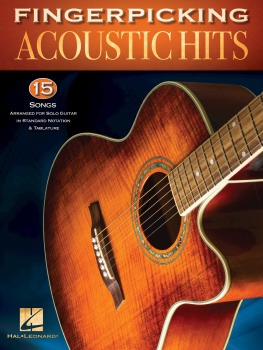Welcome to this volume of fingerpickingpatterns. I am sure you will find them to be most beneficial. If you want toknow how to finger-pick on the guitar, or just get much better at it, you will nowhave the right tools. I will share my decades of experience and give you manyof the patterns played by your favorite artists in fingerstyle guitar.
Introduction- continued
When I first started fingerpickingguitar, my teacher started me out with the basics presented in a few differentbooks. Early on, the small picking patterns were challenging, but once Imastered them, they became easier. We all start by working on what we canhandle and build upon it. In those formative years I was strumming chords ofsongs by The Eagles, The Beatles, Bob Seger, Paul Simon, Don Mclean (AmericanPie), and more. Strumming is a great place to start. Learning chords and how tochange from one to the other, is a very recommendable goal for any youngguitarist.
I once knew a 97-year-oldviolinist who said to me, "We are all limited, but the goal is to becomeless limited." That thought really stuck to me. When we first beganstudying our instrument, we could not play much, but as we practiced, we becamebetter at the instrument; thus becoming "less limited." As time wentby, we reached a new level of ability, and our finger muscles were trained todo things they could not before. As long as we practice with dedication andpatience we will progress.
When I was fingerpicking the tune,"Dust in the Wind," or "Feeling Groovy," as a teenager, Ibegan to fall in love with fingerpicking. That's what guitar playing is allabout. It's about satisfaction and enjoyment. We are creating music, andplaying it to please our ears and others, too.
When I was sixteen years old, Ibegan fingerpicking a few classical guitar pieces that my teacher introduced tome. They were much more challenging than the rock tunes I was playing. But,each song I learned, no matter what style, was making me less limited. To thisday, I will still add "Feeling Groovy" or "Dust in the Wind"in a medley I play featuring all rock tunes. Ill never forget them, and I onlybecame better at performing them.
Around the same time, I was alsoattempting some very difficult works, such as Classical Gas and Malaguena. Theywere too difficult for me when I was a young teenager and even in my twenties!I could only play a few bits and pieces of each composition, but I kept sayingto myself, "Someday I am going to be able to play those tunes." Istuck with it, and as I became less limited in fingerpicking, I eventually wasable to perform them.
I always considered myself a"blue collar" guitar player, and I feel I had to fight and scratchfor every note I had to play. I was not the prodigy, playing highly advancedfingerpicking tunes as a young teen. I did not have perfect pitch. I was notthe one to, "Pop out of my mother's womb with a guitar in my hand,"playing intricate, fingerstyle pieces. I kid, but it seems some of these young,amazing, fingerpickers were. I think most people can relate to me in the factthat I had to work harder at music then some. It did not come easy, and Iworked my way up the ladder of fingerpicking ability. Learn from my experience,that ladder never ends. We are always limited in different ways. We don't knowit all, and we never will. I still learn something from people with 30 yearsless experience! It's fun to learn new things. Playing guitar is a journey andit should always be enjoyable.
I have been teaching guitar forover 30 years, and I have been able to put myself in the shoes of the students.This is because I remembered what it was like just starting out. In this volumeI have some very basic patterns and some difficult ones for more advancedplayers. Anyone at any level can learn something from this compilation oflessons.
On my journey of guitar playing Iwas very interested in classical guitar too, and learned a good repertoire ofclassical guitar compositions, each having unique fingerpicking patterns, andchord progressions. Within those works are essential fingerpicking patternstoo. I have included some of those pieces in this volume.
I became very interested in thestyle of fingerpicking as done by Chet Atkins and Jerry Reed in the late1990's. What I heard was incredible to say the least. In my heart I knew Ineeded to learn how to do this style. It was the "missing link" in myfingerpicking. I realized how much of a difference maker it was compared toanything I learned before. But, all I had learned previously benefited me andtrained my fingers to move efficiently, and I become "less limited."Each lesson would serve as a great stepping-stone into the Chet or Travis styleof picking.
The Chet/Travis-style offingerpicking, is used, extensively, by Chet Atkins, Jerry Reed, TommyEmmanuel, Doc Watson, and of course, Merle Travis. There are so many others toname as well. This style took my playing to new heights and plateaus I couldhave never imagined.
This is why I am so excited tobring you these lessons, because I know how much they will improve your playing.Plus, they are just a whole lot of fun! Once you get a firm grasp on thisstyle, you can arrange most any song, and add the "signature,"fingerpicking style to it. You can go above and beyond the original tunes. Youwill sound like a one-man-band!
In this style, the bass, melodyand harmony are going onall at the same time. I will start you off withfingerpicking patterns that will be essential to this style. I found that, onceyou get just a couple patterns mastered, then the next ones become easier.
The most important thing is toalternate the bass notes very steady, while working the melody out above. Theuse of muffling the strings with the right hand palm (palm mute), and using thethumb pick are optional. However, they do make a huge difference in the soundthat is heard in this style.






